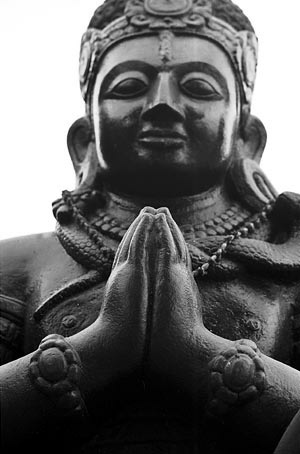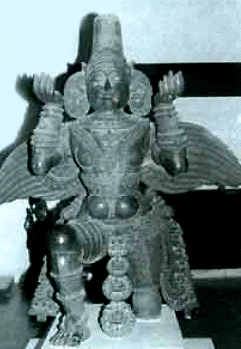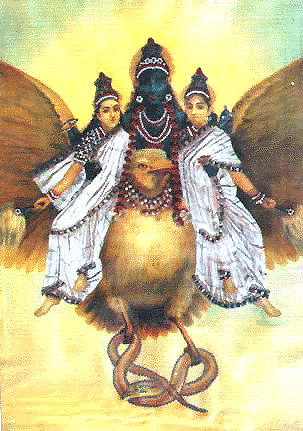Sri Garuda
BY: SUN STAFF

Dec 9, INDIA (SUN) — India is a treasure house of Sri Gaurda's murti forms.
Sri Garuda is the devata carrier (vahana) of Lord Vishnu, and is frequently depicted with Vishnu or Laksmi-Narayana on his back. The account of Garuda's birth identifies him as the younger brother of Aruna, the charioteer of the sun god, Surya. Garuda's mother was held in slavery by her co-wife and sons, who were nagas (serpents), thus we find the lasting enmity between the eagle-like kite Garuda and the snakes. The nagas agreed to release his mother if he would obtain for them a drink of the elixir of immortality, the amrta. Garuda made a great effort to perform this feat and returning from the pastime, he met Lord Visnu and agreed to serve as His vahana, or carrier.
Garuda is known by several names that describe his appearance, including Sitana (white faced); Rakta-paksha (red-winged); Swet-rohita (the white and red); Survarna-kaya (golden-bodied) and Taraswin (the swift). In sculptures and paintings across India, Garuda is depicted as having head, wings, talons and beak of an eagle, and the body and limbs of a man. His body is golden, his wings red, but his face is white. His wife is Unnati or Vinayaka and Sampati is his son.
Pictured above is one of the beautiful forms of Sri Garuda from Patan, Nepal, where Garuda has long been an intrinsic part of the local culture. A world famous Garuda sitting high atop a pillar in the Patan square has become one of the most photographed Garudas in the world. This one is mounted on a tall stone monolith outside the Jagat Narayana temple, a tall Shikhara-style temple dedicated to Lord Visnu. The temple, built of red bricks, is a beautiful backdrop for the exquisite metal statue of Garuda that rises above it.
At the Patan Museum, you will find the throne of the Patan king circa 1666, who ruled up until the Kathmandu Valley was overtaken by the Shah dynasty. The gold gilded throne is flanked by two pairs of gilt copper trees, above which is fixed Sri Garuda. The Kings of Nepal at the time not only wished for Garuda's blessings, but wished the people to believe them the actual incarnation of Lord Visnu's vahaha. Thus, Gaurda is typically associated with the thrones of the kings.

Pictured above is the Patan king's throne, which bears a humorous inscription saying that the throne can be rented for just two rupees. Situated above Garuda's head is an extraordinary mountain of the entwined bodies of nagas, whose nine heads rise above Sri Garuda.
In an article by B. Krishna Goud, we find a description of the beautiful murtis of Garuda to be found in Hyderabad, at the Salar Jung Museum. "They are in stone, metal, ivory and wood. The miniature bronze sculpture belongs to Chalukya (10th century A.D.), while the stone and wood images of this demigod, belong to the 18th century AD. These carvings are on display in the Indian art Galleries, i.e. room No.3, 3A and 4 respectively. An ivory sculpture of Garuda (early 20th century AD) is on display in Room No. 14 (Ivory Gallery).
One bronze sculpture at Salar Jung is a miniature two handed standing Garuda with wings open. He is seen opposite the figure of Sri Lakshmi, who holds a flower in her hand, near the left foot of Sri Vishnu. This Garuda is seen standing as dwibhanga, in a frontal view and with his hands dangling down. The image of Garuda in front of Lord Vishnu depicts the submissive nature of Garuda, who is always ready to serve to the God. This piece might have belonged to a temple used as utsavavigraham (uninstalled idol used during festivals).
Also found at Salar Jung is a `Standing Garuda', or a Brahmini kite with powerful open wings. As an attendant and devotee of Lord Vishnu, Garuda serves as his vehicle. The head is that of a bird and the lower part of the body is human-like. The murti has two hands, which depict an anjalimudra. The nose is long and raised and pointed. The beak of the image is slightly damaged. The sacred iconographical marks of Lord Vishnu such as discus, conch etc. are seen on the top of the prabhavali on either side of the image of Garuda in relief work.
He wears kritamakuta, (crown), beaded ornaments like earlobes, kanthahara, hara, bhujavalayas, keyuras, waist-band, padasuras, a belt like pattern hanging down from hands, anklets etc. Standing in `samabhanga', the image has an expression of adoration. The sculpture measures 70X33 cm. The style belongs to South India, probably Andhra Pradesh and it reveals the influence of Vijayanagara art.

The wood carving of Garuda shown above sits on a rectangular pedestal. It depicts him in kneeling posture, Garudaasanga, with left knee on the ground and the right leg half bent with feet resting on the ground. The front of the image from forehead to the waist level has a bronze cover. This remarkable piece is decked with ornaments in relief work.
The Vaishnavite symbol namamu is also seen on his forehead clearly. There is a wheel (chakra) design on the centre of his body. Two small bulbous rounds on the bronze cover are seen at its bottom end. His hands are raised upward as if in prayer. His powerful wings are seen open. It is also said that `his half raised hands kept open, facing to sky', are to bear the feet of his God, Vishnu when he sits on his shoulders while riding.
The central `pathka' with flutters has a design of mukhasimha in the middle, which is prominently carved. At least three wooden parts have been joined besides metal cover in the image. The body, except wings and bronze cover, is probably made in one piece of raw-wood and has several bends. His long and powerful wings are fixed at the back with screws. This sculpture, measuring 162 cm. in height and about 112 cm in width, is datable to late 18th century A.D. The technique of combination of metal and wood denote the remarkable workmanship of the artist. The piece is disintegrating at places, mainly at the right ear.
Another beautiful image to be found at Salar Jung museum is an ivory Garudavahana of Vishnu with Consorts on Garuda. This is a popular form Sri Garuda is seen in. The Lord sits on Garuda with his forehands embracing Sridevi and Bhudevi. The rear hands of the Lord hold chakra and sanka in the right and left respectively. In the case of this piece, a prabhavali rises on a stepped pedestal on the back serving as a frame to all the three divine figures and Garuda. The top of the prabhavali has a `kirtimukha with its teeth laid bear along with scroll work. The hips of the goddesses rest on the wings of the Garuda with their legs dangling down Garuda, completely in the form of a bird, is perched on a pedestal."

